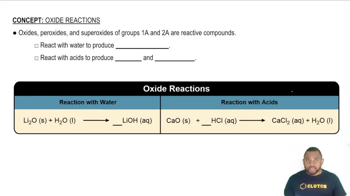Here are the essential concepts you must grasp in order to answer the question correctly.
Balancing Chemical Equations
Balancing chemical equations involves ensuring that the number of atoms of each element is the same on both sides of the equation. This is based on the law of conservation of mass, which states that matter cannot be created or destroyed in a chemical reaction. To balance an equation, coefficients are adjusted in front of the chemical formulas to achieve equal atom counts.
Recommended video:
Balancing Chemical Equations
Combustion Reactions
Combustion reactions occur when a substance reacts with oxygen, typically producing heat and light. In the case of elements reacting with excess O2, the products are often oxides of the elements. For example, carbon reacts with oxygen to form carbon dioxide, while calcium reacts to form calcium oxide. Understanding the type of reaction helps predict the products formed.
Recommended video:
Oxides of Elements
Oxides are compounds formed when elements react with oxygen. Each element has a specific oxide it forms based on its oxidation state and bonding characteristics. For instance, carbon forms CO or CO2, while calcium forms CaO. Recognizing the common oxides of elements is essential for writing balanced equations in combustion reactions.
Recommended video:
 Verified step by step guidance
Verified step by step guidance

